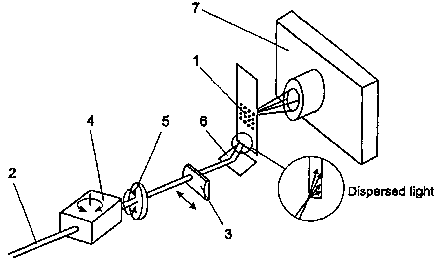Some of the information on this Web page has been provided by external sources. The Government of Canada is not responsible for the accuracy, reliability or currency of the information supplied by external sources. Users wishing to rely upon this information should consult directly with the source of the information. Content provided by external sources is not subject to official languages, privacy and accessibility requirements.
Any discrepancies in the text and image of the Claims and Abstract are due to differing posting times. Text of the Claims and Abstract are posted:
| (12) Patent Application: | (11) CA 2335438 |
|---|---|
| (54) English Title: | METHOD AND DEVICE FOR IMAGING AND ANALYSIS OF BIOPOLYMER ARRAYS |
| (54) French Title: | PROCEDES ET DISPOSITIF D'IMAGERIE ET D'ANALYSE DE JEUX ORDONNES D'ECHANTILLONS DE BIOPOLYMERES |
| Status: | Deemed Abandoned and Beyond the Period of Reinstatement - Pending Response to Notice of Disregarded Communication |
| (51) International Patent Classification (IPC): |
|
|---|---|
| (72) Inventors : |
|
| (73) Owners : |
|
| (71) Applicants : |
|
| (74) Agent: | KIRBY EADES GALE BAKER |
| (74) Associate agent: | |
| (45) Issued: | |
| (86) PCT Filing Date: | 2000-04-20 |
| (87) Open to Public Inspection: | 2000-10-26 |
| Availability of licence: | N/A |
| Dedicated to the Public: | N/A |
| (25) Language of filing: | English |
| Patent Cooperation Treaty (PCT): | Yes |
|---|---|
| (86) PCT Filing Number: | PCT/EE2000/000001 |
| (87) International Publication Number: | EE2000000001 |
| (85) National Entry: | 2000-12-15 |
| (30) Application Priority Data: | ||||||
|---|---|---|---|---|---|---|
|
Total internal reflection fluorescence is used for imaging biopolymer arrays.
A beam of light (2) is guided into the solid support (1) at a certain angle,
evoking total internal reflection in the solid support. A certain portion of
light will not reflect from the inner glass surface but penetrate out of the
glass as an evanescent wave. It will excite fluorophores incorporated in the
biopolymer molecules, contiguously attached to the surface of the support.
Fluorescence thus evoked will be guided to a light sensitive element (7),
providing data on the fluorescent molecules attached to the surface of the
support. The said detection of fluorescence signals is rapid, taking about 10
seconds per fluorescence channel.
La fluorescence de la réflexion totale interne est utilisée pour l'imagerie de jeux ordonnés d'échantillons de biopolymères. Un faisceau de lumière (2) est dirigé à l'intérieur d'un support solide (1) à un certain angle, provoquant une réflexion totale interne dans le support solide. Une certaine partie de la lumière ne sera pas reflétée à partir de la surface de verre interne mais va sortir hors du verre sous la forme d'une onde évanescente. Elle va exciter les fluorophores incorporées dans les molécules de biopolymère, fixées de manière adjacente à la surface du support. La fluorescence ainsi provoquée va être dirigée vers un élément photosensible (7), fournissant des données concernant les molécules fluorescentes fixées à la surface du support. Ladite détection de signaux de fluorescence est rapide, parcourant en dix secondes environ chaque canal de fluorescence.
Note: Claims are shown in the official language in which they were submitted.
Note: Descriptions are shown in the official language in which they were submitted.

2024-08-01:As part of the Next Generation Patents (NGP) transition, the Canadian Patents Database (CPD) now contains a more detailed Event History, which replicates the Event Log of our new back-office solution.
Please note that "Inactive:" events refers to events no longer in use in our new back-office solution.
For a clearer understanding of the status of the application/patent presented on this page, the site Disclaimer , as well as the definitions for Patent , Event History , Maintenance Fee and Payment History should be consulted.
| Description | Date |
|---|---|
| Inactive: IPC expired | 2014-01-01 |
| Inactive: IPC from MCD | 2006-03-12 |
| Application Not Reinstated by Deadline | 2004-04-20 |
| Time Limit for Reversal Expired | 2004-04-20 |
| Deemed Abandoned - Failure to Respond to Maintenance Fee Notice | 2003-04-22 |
| Inactive: Entity size changed | 2002-05-06 |
| Letter Sent | 2001-11-21 |
| Inactive: Single transfer | 2001-10-24 |
| Inactive: Entity size changed | 2001-05-24 |
| Inactive: Cover page published | 2001-04-05 |
| Inactive: IPC removed | 2001-03-26 |
| Inactive: First IPC assigned | 2001-03-26 |
| Inactive: First IPC assigned | 2001-03-25 |
| Inactive: Courtesy letter - Evidence | 2001-03-20 |
| Inactive: Notice - National entry - No RFE | 2001-03-14 |
| Application Received - PCT | 2001-03-13 |
| Application Published (Open to Public Inspection) | 2000-10-26 |
| Abandonment Date | Reason | Reinstatement Date |
|---|---|---|
| 2003-04-22 |
The last payment was received on 2002-04-22
Note : If the full payment has not been received on or before the date indicated, a further fee may be required which may be one of the following
Patent fees are adjusted on the 1st of January every year. The amounts above are the current amounts if received by December 31 of the current year.
Please refer to the CIPO
Patent Fees
web page to see all current fee amounts.
| Fee Type | Anniversary Year | Due Date | Paid Date |
|---|---|---|---|
| Basic national fee - standard | 2000-12-15 | ||
| Registration of a document | 2000-12-15 | ||
| MF (application, 2nd anniv.) - standard | 02 | 2002-04-22 | 2002-04-22 |
Note: Records showing the ownership history in alphabetical order.
| Current Owners on Record |
|---|
| ASPER OU |
| Past Owners on Record |
|---|
| ANDRES METSPALU |
| ANTS KURG |
| JEVGENI BERIK |